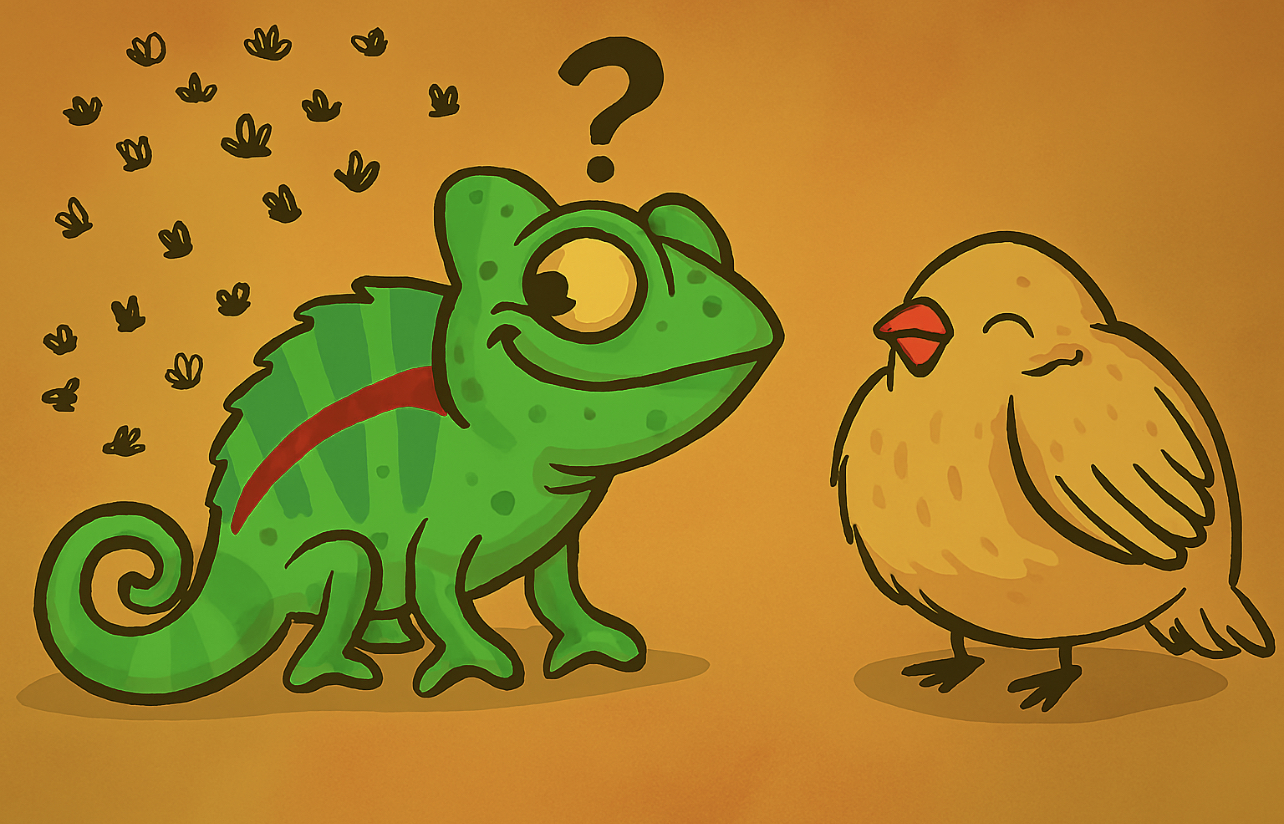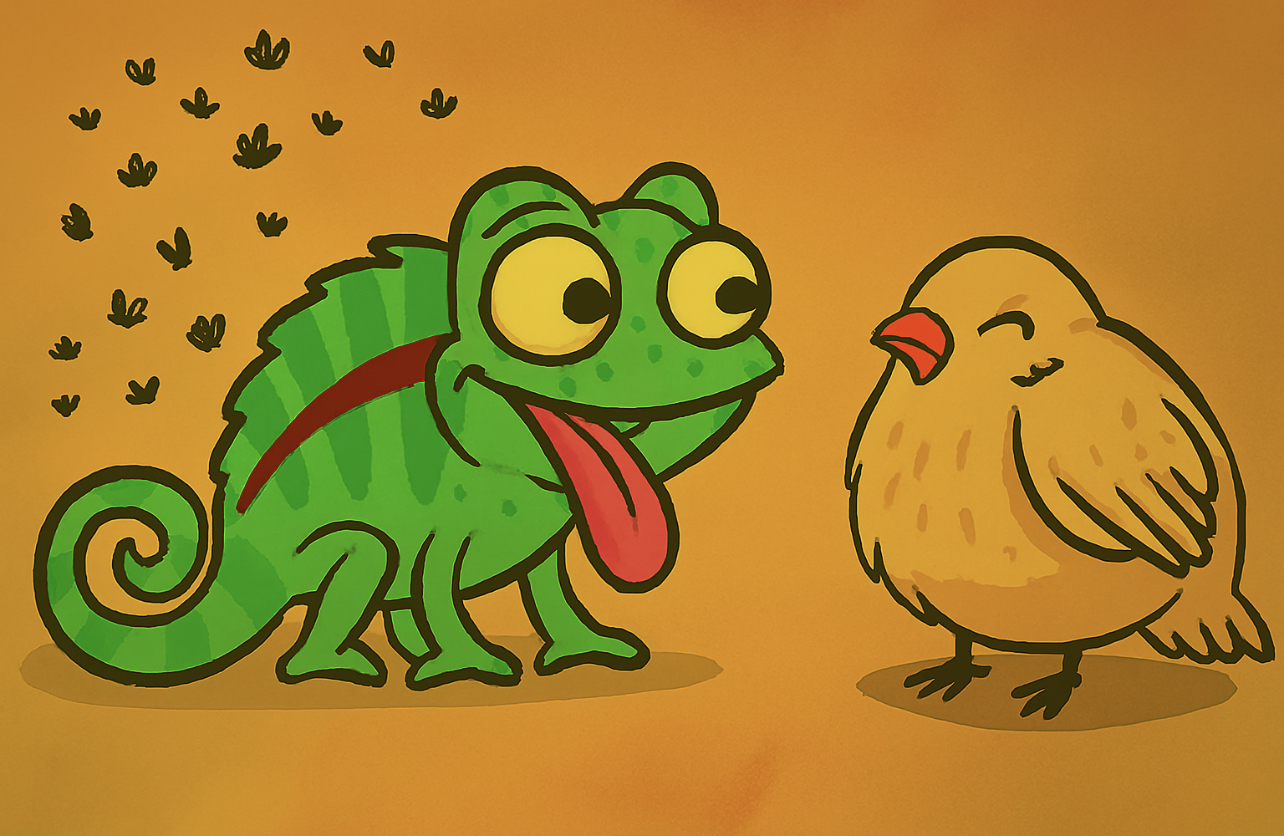Myth 26: “Chameleons Should Eat Every Day — They Shouldn’t Starve”


Reality: Not true.
Chameleons are ectothermic animals. Unlike mammals and birds, they don't maintain a constant internal temperature. This means they don't require a continuous energy supply to fuel thermoregulation. Their energy needs fluctuate with ambient temperature, activity level, and life stage.
Feeding Biology: Specialists & Opportunists
Chameleons are both:
Food specialists: They extract nutrition from low-energy prey by discarding indigestible parts like: Beetle wings, bee and wasp heads, tough exoskeletons
Food opportunists: They feed based on availability, not preference. As sit-and-wait predators or cruise foragers, they eat what comes their way:
If small insects are abundant, they eat many.
If they find a carcass with flies and carrion beetles, they eat those.
If they spot a bird, they might shoot it.
Their feeding is task-driven by availability, not strategic planning. A full chameleon may ignore ants or beetles, but after two months of dry-season starvation, it'll eat anything to survive.
Feeding Frequency in Nature: Two Extremes
1. Frequent grazing
Dozens of small bites daily
Intestines work like a conveyor belt
Regular defecation
2. Feast and fast
One large, fatty prey (e.g. bird, gecko, cicada)
No feeding for 1–2 weeks or more
No defecation for up to 6 weeks
One massive deposit when digestion completes
Both patterns are entirely natural.
Why Captive Chameleons Become Picky
Captivity compresses their environment and removes the need to hunt. Overfeeding leads to:
Laziness
Picky behavior
Refusal to move toward prey
"Princess syndrome" — rejecting food unless it's perfect
Feeding in Captivity: You Decide, They Don't Care
The key is total energy intake over time, not daily feeding.
Your goal is to avoid both obesity and starvation.
How to Calculate Daily Energy Needs
Let's use a baseline:
One large Gryllus assimilis gutloaded with 5 pollen granules ≈ fully satisfies a 100g Chamaeleo calyptratus
A 200g Furcifer pardalis ≈ needs two of these crickets
This applies to adults outside breeding season.
Temperature Impact
Metabolic rate increases with temperature:
At 68°F (20°C) → baseline energy need
At 78°F (25.5°C) → energy demand increases by ~2.5×
So, feeding must be adjusted seasonally and thermally.
Equivalent Prey Options
To match the energy of one large cricket:
~2–3 pollen loaded bees
~10–15 black soldier flies
~1 large hornworms (it is full of water, dry matter is almost equal to or even less than gut-loaded cricket)
Chameleons Don't Starve from Skipping Meals
If they receive adequate nutrition over time, missing meals is harmless.
What to Do with an Obese Chameleon
Feed less. Period.
Reducing to "normal" intake won't reverse obesity. You must create a deficit to burn fat reserves. This discomfort is your responsibility — it's life-saving, not cruel.
Strategies to Reduce Feeding
Scheduled fasting (e.g. skip one week per month)
Fewer feeders per meal
Smaller prey items
Best: Combine all three
Monitor progress through:
Visual observation
Regular weighing
What If Your Chameleon Is Underweight?
First, rule out illness, weight loss, dehydration, and poor condition may signal:
Coccidia
Pinworms
Other infections
Then:
Feed more frequently
Offer larger, energy-rich prey
Ensure hydration and proper supplementation
Final Thought
Chameleons are not machines. They are adaptive, opportunistic survivors.
Feeding should reflect their biology — not our routines.
Whether it's feast or famine, what matters is balance over time, not daily consistency.
Care wisely. Observe. Adjust. Respect their nature.